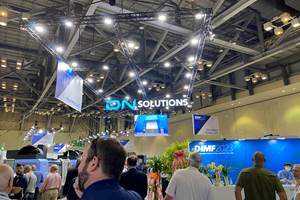Minimizing Offset Changes From Job To Job
Some companies store all cutting tools they ever use in the CNC machine's magazine or turret. Others have a number of tools that they keep in the machine on a permanent basis.
Share





Some companies store all cutting tools they ever use in the CNC machine's magazine or turret. Others have a number of tools that they keep in the machine on a permanent basis. For these and any other tool that is currently in the machine at the time a setup is made—your setup people should not have any measurement or offset entry tasks to perform.
On machining centers, typically there are offsets for tool length and cutter radius compensation. For tool length compensation, we recommend using the distance from tool tip to spindle nose. This value will not change for the tool as you go from setup to setup. Some people use the distance from the tool tip down to the program zero surface in Z as the tool length compensation offset. If the program zero surface in Z changes from job to job, as it normally will, so will the offset value for any tool being used.
When it comes to cutter radius compensation, programming methods must be consistent if offset values are to remain the same. If you program work surface paths, as most manual programmers do, the cutter radius offset will be the radius of the cutting tool. If you program the cutter's centerline path, as many CAM system programmers prefer, the offset will be the radial difference from the planned to the actual cutter size. Regardless of which method you use, if it's kept consistent, cutter radius compensation offsets will remain the same.
The offsets for turning centers include geometry offsets (for program zero assignment), wear offsets and tool nose radius compensation offsets.
Geometry offsets for the X axis will not change from job to job because the program zero point is the workpiece/spindle centerline, which is a constant. But in the Z axis, program zero is commonly placed at the left or right end of the finished workpiece. If the Z axis geometry offset is set to the distance from the tool tip to one end of the workpiece, it will change, making it necessary to re-measure geometry offset Z values for all tools used in every job.
To eliminate these time consuming measurements, your turning machine must have a work shift function. With work shift, you can choose a more consistent Z surface, such as the chuck face, for your geometry offset measurements. Since the chuck face doesn't change from job to job, neither will your geometry offset Z values. The work shift value will tell the control how far it is from the chuck face to the actual program zero point in the program. While it may have to be measured, this is still only one entry compared to the several that are commonly required for tools left in the turret from job to job.
For wear offsets, our points assume that geometry offsets are used as just presented. If a tool is cutting a workpiece to size in one job, meaning that you have the wear offset properly adjusted, it will continue to do so in the next job. (The only exception to this statement would be a dramatic difference in workpiece material, causing a tool pressure deviation.) But it will also be necessary to ensure that the target dimension for each programmed surface (commonly the mean value of the tolerance band) remain consistent.
When it comes to tool nose radius compensation, the type (T specification) and radius (R specification) of the tool will not change from job to job. So that's one you don't have to worry about at all.
Related Content
Workholding Fixtures Save Over 4,500 Hours of Labor Annually
All World Machinery Supply designs each fixture to minimize the number of operations, resulting in reduced handling and idle spindle time.
Read MoreDN Solutions Responds to Labor Shortages, Reshoring, the Automotive Industry and More
At its first in-person DIMF since 2019, DN Solutions showcased a range of new technologies, from automation to machine tools to software. President WJ Kim explains how these products are responses to changes within the company and the manufacturing industry as a whole.
Read MoreFinding Skilled Labor Through Partnerships and Benefits
To combat the skilled labor shortage, this Top Shops honoree turned to partnerships and unique benefits to attract talented workers.
Read MoreHow to Pass the Job Interview as an Employer
Job interviews are a two-way street. Follow these tips to make a good impression on your potential future workforce.
Read MoreRead Next
Setting Up the Building Blocks for a Digital Factory
Woodward Inc. spent over a year developing an API to connect machines to its digital factory. Caron Engineering’s MiConnect has cut most of this process while also granting the shop greater access to machine information.
Read MoreBuilding Out a Foundation for Student Machinists
Autodesk and Haas have teamed up to produce an introductory course for students that covers the basics of CAD, CAM and CNC while providing them with a portfolio part.
Read More5 Rules of Thumb for Buying CNC Machine Tools
Use these tips to carefully plan your machine tool purchases and to avoid regretting your decision later.
Read More
.jpg;width=70;height=70;mode=crop)
















.jpg;maxWidth=300;quality=90)













